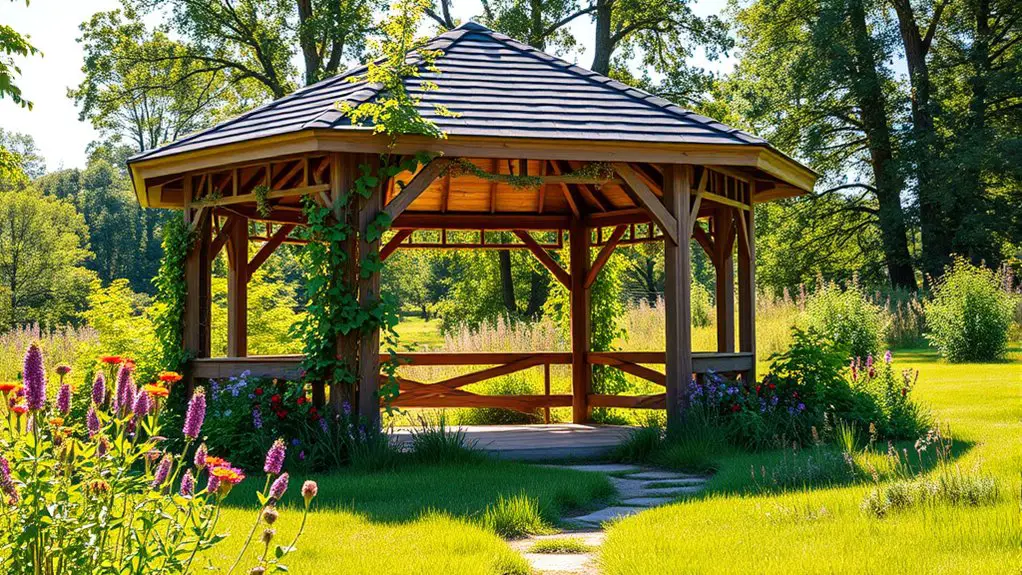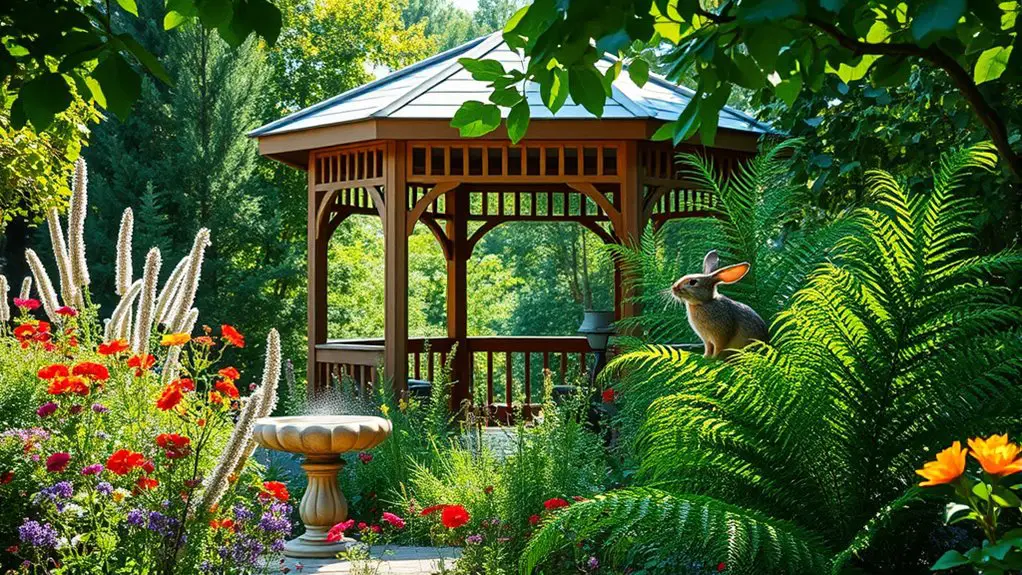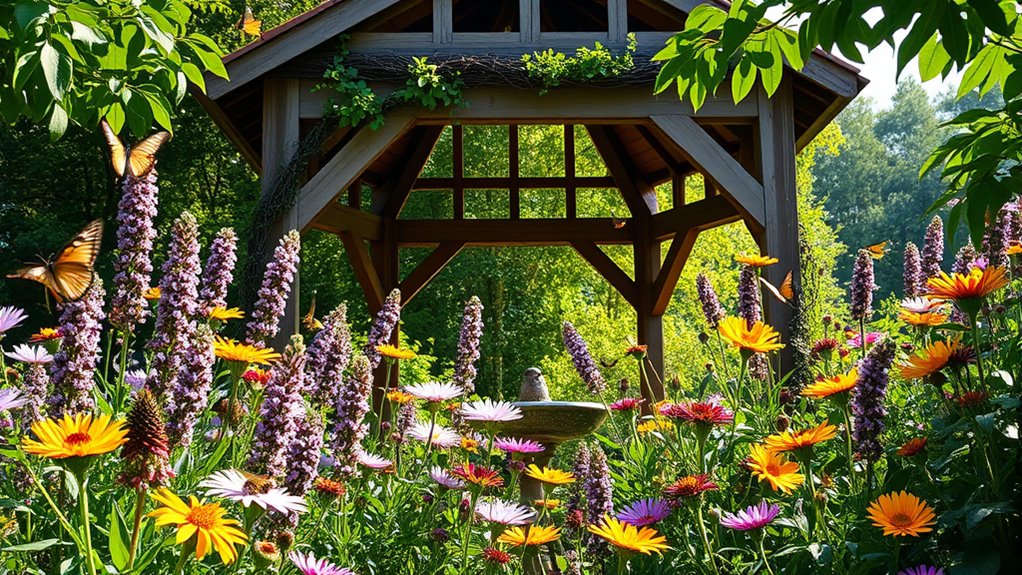Creating a wildlife habitat around your gazebo draws in vibrant birds and pollinators. Start by choosing native plants like coneflowers and black-eyed Susans, which thrive in your climate and attract wildlife. Incorporate water features for hydration and breeding spots that enhance biodiversity. Don’t forget to add shelter, like birdhouses and brush piles, to provide safe spaces for animals. With the right elements in place, your gazebo can become a lively centerpiece of a flourishing ecosystem, inviting even more wonders to explore.
Choosing Native Plants for Your Habitat

When you think about creating a wildlife habitat around your gazebo, the right plants can transform your space into a vibrant ecosystem. Choosing native plants offers numerous benefits; they’re adapted to your local climate, require less water, and attract local wildlife. Imagine the thrill of watching butterflies dance around your coneflowers or hummingbirds flit through your trumpet vines.
Seasonal plant selection plays a significant role in maintaining interest and supporting diverse species year-round. Spring blooms like bluebells can herald the season, while autumn asters provide late-season nourishment for pollinators.
Incorporating Water Features
Adding water features to your gazebo area can transform it into a vibrant wildlife sanctuary. From serene ponds to bubbling fountains, each type not only enhances the beauty of your space but also attracts a variety of birds and beneficial insects. With a bit of maintenance and care, these features can become the heartbeat of your garden, inviting life and movement all around.
Types of Water Features
While you’re planning your gazebo’s surroundings, incorporating water features can transform the space into a vibrant wildlife habitat. Consider different pond types, like naturalistic ponds that mimic a serene ecosystem or formal ponds with clean lines for a modern touch. Each style invites unique aquatic life, enhancing biodiversity. Alternatively, explore fountain styles—such as tiered or wall-mounted options—that create soothing sounds and attract birds, butterflies, and beneficial insects. The gentle splashing of water not only adds a dynamic element but also provides essential hydration for your wildlife visitors. Whether you choose a tranquil pond or an elegant fountain, these features will harmonize beautifully with your gazebo, creating a sanctuary where nature thrives and you can unwind freely.
Attracting Wildlife Benefits
By incorporating water features into your gazebo’s habitat, you’re not just enhancing the aesthetics; you’re also creating a thriving ecosystem that attracts a diverse range of wildlife. The gentle sound of trickling water calls in birds, while butterflies flutter around the vibrant plants that flourish nearby. A small pond or fountain can provide essential hydration and breeding spots for frogs and beneficial insects, all contributing to the ecological balance of your garden. These wildlife benefits extend to pest control as natural predators settle in, reducing the need for chemical interventions. By nurturing this vibrant environment, you’re inviting nature to flourish, enriching your outdoor experience, and fostering a deeper connection with the wild world around you.
Maintenance and Care Tips
To guarantee your water features thrive and continue attracting wildlife, regular maintenance is essential. Here are some key tips to verify habitat sustainability and promote wildlife conservation:
- Clean Regularly: Remove debris and algae to keep water clear and inviting for birds and beneficial insects.
- Monitor Water Levels: Verify adequate water levels, topping off as necessary to maintain a healthy ecosystem.
- Check for Leaks: Inspect features for any leaks, as a steady water supply is vital for attracting diverse wildlife.
- Plant Wisely: Incorporate native aquatic plants to provide shelter and food sources, enhancing the overall habitat.
Providing Shelter and Nesting Sites
Creating a wildlife-friendly environment around your gazebo can greatly enhance the natural beauty of your outdoor space, especially when you prioritize providing shelter and nesting sites. By incorporating various shelter structures, you can create a safe haven for birds, small mammals, and beneficial insects. Consider adding birdhouses, bat boxes, or even native shrubs to encourage wildlife habitation.
Here’s a quick reference table for effective shelter options:
| Shelter Type | Materials Needed | Benefits |
|---|---|---|
| Birdhouses | Wood, nesting materials | Safe nesting site |
| Bat Boxes | Wood, insulation | Pest control |
| Brush Piles | Natural debris | Habitat for small animals |
| Native Shrubs | Native plants | Food and cover |
Creating Food Sources for Wildlife

After establishing shelter for wildlife around your gazebo, the next step involves ensuring a steady supply of food sources to attract and sustain various species. By incorporating diverse food plants, you’ll create a vibrant ecosystem that draws in birds, butterflies, and other critters. Here’s how you can do it:
- Native Seed Types: Choose seeds from local plants that wildlife naturally eat, like sunflowers or coneflowers.
- Fruit-Bearing Shrubs: Plant berry-producing shrubs such as elderberry or serviceberry to provide seasonal nourishment.
- Nectar-Rich Flowers: Include flowering plants like milkweed and bee balm that offer nectar for pollinators.
- Grasses and Grains: Add ornamental grasses or grains, like millet, which can serve as food and shelter.
These elements create a banquet for wildlife, ensuring they feel welcome and at home around your gazebo. With thoughtful planning, you’ll invite nature to thrive in your space.
Designing Wildlife-Friendly Landscapes
While designing wildlife-friendly landscapes around your gazebo, it’s essential to blend aesthetics with functionality, ensuring that every element serves a purpose for the local fauna. Start by incorporating native plants; they not only thrive in your environment but also provide essential food and shelter for wildlife. Create wildlife corridors that connect various habitats, allowing animals safe passage and promoting habitat connectivity. Consider adding diverse layers of vegetation, such as tall trees for birds, shrubs for small mammals, and ground cover for insects. Water features, like small ponds or birdbaths, attract a variety of creatures while enhancing the landscape’s beauty. Avoid using pesticides to maintain a healthy ecosystem, and instead, embrace natural pest control methods. By thoughtfully designing your landscape, you create a vibrant haven for wildlife, fostering a sense of freedom and harmony that enriches both your outdoor space and the lives of its inhabitants.
Attracting Pollinators to Your Gazebo

As you enhance the area around your gazebo, attracting pollinators becomes a rewarding goal that benefits both your garden and the local ecosystem. Creating vibrant pollinator gardens not only beautifies your space but also invites essential creatures like bees and butterflies. Here’s how to get started:
- Choose Native Plants: Select flowers native to your region; they’re more attractive to local pollinators.
- Create Diverse Blooms: Plant a variety of species to guarantee blossoms from spring through fall, providing continuous food sources.
- Install Bee Hotels: Set up bee hotels around your gazebo to offer safe nesting spots for solitary bees.
- Avoid Pesticides: Keep your garden chemical-free to protect the delicate balance of life.
With these strategies, you’ll create a sanctuary that thrives with pollinators, enhancing both your outdoor experience and the environment. Enjoy the buzzing life around your gazebo!
Implementing Sustainable Practices
To create a thriving wildlife habitat around your gazebo, consider integrating sustainable practices that enhance both beauty and biodiversity. Selecting native plants not only supports local ecosystems but also reduces maintenance, while implementing water conservation methods guarantees your garden remains lush without excessive resource use. Additionally, adopting organic pest management keeps your outdoor space healthy and vibrant, fostering a sanctuary for pollinators and other wildlife.
Native Plant Selection
Choosing the right native plants for your gazebo’s surrounding habitat not only enhances its aesthetic appeal but also fosters a thriving ecosystem. By prioritizing native species, you’ll promote plant diversity and ecological balance, allowing local wildlife to flourish. Here are four plants to evaluate:
- Coneflower – Vibrant and drought-resistant, attracting pollinators.
- Black-eyed Susan – Hardy blooms that provide seeds for birds in winter.
- Butterfly weed – A magnet for butterflies, supporting their lifecycle.
- Joe Pye weed – Tall and striking, perfect for attracting beneficial insects.
These native plants create a beautiful tapestry while inviting wildlife, ensuring your gazebo is not just a structure but a sanctuary where nature thrives.
Water Conservation Methods
While creating a wildlife-friendly habitat around your gazebo, it’s essential to contemplate water conservation methods that not only benefit the environment but also enhance your landscape’s sustainability. One effective practice is rainwater harvesting; by installing a simple collection system, you can gather rainwater from your roof, channeling it to a storage barrel. This resource can then be used to nourish your plants during drier spells. Additionally, consider drought-resistant landscaping by incorporating native plants that thrive with minimal water. These resilient species not only conserve water but also attract beneficial wildlife. By combining rainwater harvesting with drought-resistant landscaping, you’ll create a flourishing habitat that’s both eco-friendly and a stunning retreat for you and the creatures you cherish.
Organic Pest Management
As you cultivate a wildlife-friendly environment around your gazebo, implementing organic pest management practices can considerably enhance the health of your garden. By focusing on natural solutions, you can encourage a balanced ecosystem. Here are some effective strategies you can adopt:
- Pest Identification Techniques: Learn to recognize pests and their life cycles for targeted management.
- Beneficial Insects: Introduce ladybugs and lacewings to keep harmful pests in check.
- Companion Planting: Use plants that naturally repel pests or attract beneficial insects.
- Natural Predators: Create habitats for birds and bats that feast on undesirable insects.
With these practices, you’ll not only protect your plants but also foster a vibrant and diverse wildlife habitat around your gazebo.
Enjoying and Observing Your Wildlife Habitat
Creating a vibrant wildlife habitat around your gazebo transforms your outdoor space into a living tapestry of nature. You’ll find joy in wildlife observation as colorful birds flit by and playful squirrels dart around. With a camera in hand, nature photography becomes second nature, capturing fleeting moments of beauty.
To enhance your experience, consider these essential elements:
| Element | Description |
|---|---|
| Native Plants | Attract local pollinators |
| Water Sources | Provide hydration for wildlife |
| Feeders | Offer food for birds |
| Shelter | Create refuge for small animals |
| Viewing Areas | Designate spots for observation |
Frequently Asked Questions
What Types of Wildlife Are Most Commonly Attracted to Gazebos?
Imagine a serene haven where bird species flit about, and insect visitors dance in the sun. Gazebos naturally attract these creatures, providing a vibrant tapestry of life, enriching your outdoor experience with nature’s wonders.
How Can I Discourage Pests Without Harming Beneficial Wildlife?
To discourage pests, use organic repellents like neem oil, and consider companion planting. Strategically placed herbs or flowers can repel unwanted insects while inviting beneficial ones, ensuring your garden thrives harmoniously without harming nature’s allies.
Is There a Specific Time of Year to Start Creating My Habitat?
You might think it’s too early, but spring’s the perfect time for planting. Consider seasonal factors; as nature awakens, you’ll attract diverse wildlife. Timing your efforts guarantees a thriving habitat for all its inhabitants.
Can I Use Non-Native Plants in My Wildlife Habitat?
You can use non-native plants, but be cautious. Native plants offer essential benefits like supporting wildlife. Non-natives may introduce invasive species risks, disrupting local ecosystems. Choose wisely for a thriving, balanced habitat that fosters freedom and harmony.
How Do I Maintain My Wildlife Habitat Year-Round?
Did you know 75% of wildlife relies on seasonal habitats? To maintain your wildlife refuge year-round, focus on seasonal maintenance and habitat monitoring. Regularly check plant health, adjust watering, and guarantee food sources thrive through changing seasons.

